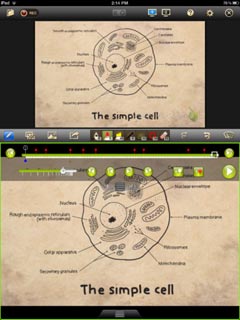
Students do not see the zooming in and out, but it is not easy for an instructor to do this in real time. When that is done, the drawings are smaller than an instructor would otherwise be able to do, and more can be fitted on a page. To do this, an instructor must zoom in to an area, draw, and then zoom out. The disadvantage is that it can be tricky to draw small enough to fit, for example, an entire reaction mechanism on one screen. Figure 2ĭoceri can also be used as a whiteboard (or other background there are 48 different backgrounds from which to choose) and figures can be drawn on it (Figure 3). If an instructor wishes to add something in writing to what is on the slides, it can be done directly on the slide rather than on a chalkboard.


Instead of using a laser pointer to highlight items being discussed, an instructor can more directly highlight items of interest. These features are just as useful in resident instruction as in VLN classes. (7) From there, the slides can be downloaded onto a desktop computer. This feature allows an instructor to post annotated slides online for students, which is done by uploading from an iPad to a Web site such as Dropbox, a file sharing site. If a screen becomes too cluttered with drawings, one touch of the “erase all strokes” button removes the drawings but they are not lost because another nice feature is that Doceri automatically saves a screen capture whenever something is drawn. Drawings can be done in many different colors. An instructor can also draw structures or make annotations on slides while talking, which eliminates moving around and switching displays (Figure 2). In this way, an instructor can use PowerPoint (6) slides for lectures and underline, circle, or draw an arrow to anything an instructor wants to highlight, which solves the pointing problem. Once connected, an instructor can draw on an iPad using a finger or a stylus, and the drawings show up on a desktop that is being shared, on top of whatever is already being shown (e.g., an application, a document, or a Web site). For the most part, the system works well, but some difficulties with the system include the inability to point easily to things shown on the screen, and, in order to draw something, such as a mechanism, an instructor has to switch from the screen on the computer to an overhead projector, and then move over to draw on the paper. When a student wants to ask a question, he or she presses a button and a camera in the front of the room zooms in on that student while an overheard microphone picks up the audio. If an instructor leaves the pad, the camera zooms out, so most of the room is visible. If an instructor stands on a sensor pad behind a podium, a camera in the rear of the room stays zoomed in on the instructor.

Students can see an instructor, and an instructor can see students.

#Doceri desktop for windows software#
(1) VLN classrooms, using Polycom technology, (2) have a large-screen television, multiple cameras and microphones, and computer software that allows an instructor to share the desktop computer screen or a document that can be handwritten (Figure 1). Using a video learning network (VLN), an instructor can teach to multiple campuses at the same time.


 0 kommentar(er)
0 kommentar(er)
